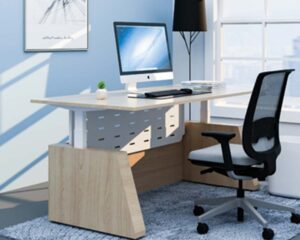Introduction: In our modern lives, we strive for comfort, convenience, and versatility, while also cherishing the warmth and simplicity of tradition. The combination of electric desks and traditional wooden tables represents the epitome of blending tradition with modernity. This article will explore the charm of merging electric desks with traditional wooden tables and how they create a unique and stylish ambiance in our homes.

- The Warmth and Texture of Traditional Wooden Tables
- Natural beauty: Traditional wooden tables are beloved for their unique grain patterns and textures. Each piece of wood tells its own story, adding personality and uniqueness to the table. Whether it’s oak, walnut, or pine, wooden tables bring a warm and rustic appearance, infusing our living spaces with a natural and earthy element.
- Handcrafted allure: Traditional wooden tables are often crafted by skilled artisans, showcasing their craftsmanship and attention to detail. The allure of handcrafted work makes each table a one-of-a-kind piece of art, providing a sense of satisfaction and pride.

- The Modern Features of Electric Desks
- Seamless height adjustment: Electric desks come with automatic height adjustment capabilities, allowing for effortless customization of the tabletop height to accommodate different work requirements and body postures. Whether you prefer sitting or standing while working, electric desks offer the optimal working experience. This flexibility and convenience enable you to stay comfortable and enhance productivity.
- Smart controls: Many electric desks are equipped with smart control panels or mobile applications, making height adjustments simple and convenient. You can set and save multiple height presets according to your preferences, easily switching to your preferred working height without the need for repetitive adjustments or memorization.

- Creating a Perfect Blend in Home Environments
- Harmonizing tradition and modernity: Combining electric desks with traditional wooden tables allows for the creation of a unique and stylish home environment. By cleverly integrating the electric mechanism into the traditional wooden table, concealing the motor, the original appearance and texture of the tabletop are preserved while enjoying the modern functionality.
- Personalized customization: You can choose different types and styles of traditional wooden tables based on your preferences and needs, and combine them with the height adjustment functionality of electric desks. This way, you can create a one-of-a-kind living space that showcases your personal taste and style.
Conclusion: The combination of electric desks and traditional wooden tables offers the perfect fusion of tradition and modernity. Traditional wooden tables bring forth the charm of warmth and simplicity, while electric desks provide modern height adjustment capabilities. By merging these two elements, we can create a unique and stylish ambiance in our homes. Whether working or relaxing, this combination offers comfort and convenience. Let’s enjoy the perfect blend of tradition and modernity in our homes!
I hope this blog translation meets your needs! If you have any other questions or need further assistance, feel free to ask.


